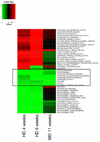Dietary methyl donor depletion protects against intestinal tumorigenesis in Apc(Min/+) mice
- PMID: 22677908
- PMCID: PMC3397832
- DOI: 10.1158/1940-6207.CAPR-11-0544
Dietary methyl donor depletion protects against intestinal tumorigenesis in Apc(Min/+) mice
Abstract
Despite recent population data, the influence of dietary folate supplementation on colon cancer risk remains controversial. This study examines the effects of folate deficiency, in combination with choline, methionine, and vitamin B12 depletion, on intestinal tumorigenesis in Apc(Min/+) mice. Methyl donor sufficient (MDS) and deficient (MDD) diets were started at five or 10 weeks of age and tumors evaluated at 16 weeks. MDD suppressed intestinal tumor formation in Apc(Min/+) mice (~80%) when started at five weeks of age. The protective effect was lost when MDD was initiated at 10 weeks of age, indicating an important time dependency on cancer suppression. Concomitant with cancer protection, MDD restricted body weight gain. Therefore, a second study was conducted in which MDS was given ad libitum or pair-fed with MDD. Although small intestinal tumors were reduced 54% in pair-fed MDS mice, MDD caused a further reduction (96%). In colon, although MDD did not affect tumor numbers, tumor size was reduced. Gene expression profiling of normal-appearing colonic mucosa after 11 weeks on MDD identified a total of 493 significantly downregulated genes relative to the MDS group. Pathway analysis placed many of these genes within general categories of inflammatory signaling and cell-cycle regulation, consistent with recently published human data obtained during folate depletion. Further studies are warranted to investigate the complex interplay of methyl donor status and cancer protection in high-risk populations.
©2012 AACR.
Figures















Similar articles
-
Dietary Methyl Donor Depletion Suppresses Intestinal Adenoma Development.Cancer Prev Res (Phila). 2016 Oct;9(10):812-820. doi: 10.1158/1940-6207.CAPR-16-0042. Epub 2016 Aug 16. Cancer Prev Res (Phila). 2016. PMID: 27530130 Free PMC article.
-
Effects of dietary folate on intestinal tumorigenesis in the apcMin mouse.Cancer Res. 2000 Oct 1;60(19):5434-40. Cancer Res. 2000. PMID: 11034085
-
Improved innate immune responses by Frondanol A5, a sea cucumber extract, prevent intestinal tumorigenesis.Cancer Prev Res (Phila). 2015 Apr;8(4):327-37. doi: 10.1158/1940-6207.CAPR-14-0380. Epub 2015 Feb 5. Cancer Prev Res (Phila). 2015. PMID: 25657017 Free PMC article.
-
Gender-specific modulation of tumorigenesis by folic acid supply in the Apc mouse during early neonatal life.Br J Nutr. 2008 Mar;99(3):550-8. doi: 10.1017/S0007114507819131. Epub 2007 Sep 10. Br J Nutr. 2008. PMID: 17868491
-
Impact of Dnmt1 deficiency, with and without low folate diets, on tumor numbers and DNA methylation in Min mice.Carcinogenesis. 2003 Jan;24(1):39-45. doi: 10.1093/carcin/24.1.39. Carcinogenesis. 2003. PMID: 12538347
Cited by
-
Suppression of colon carcinogenesis by targeting Notch signaling.Carcinogenesis. 2013 Oct;34(10):2415-23. doi: 10.1093/carcin/bgt191. Epub 2013 Jun 1. Carcinogenesis. 2013. PMID: 23729655 Free PMC article.
-
The Timing and Duration of Folate Restriction Differentially Impacts Colon Carcinogenesis.Nutrients. 2021 Dec 21;14(1):16. doi: 10.3390/nu14010016. Nutrients. 2021. PMID: 35010891 Free PMC article.
-
Molecular pathological epidemiology of epigenetics: emerging integrative science to analyze environment, host, and disease.Mod Pathol. 2013 Apr;26(4):465-84. doi: 10.1038/modpathol.2012.214. Epub 2013 Jan 11. Mod Pathol. 2013. PMID: 23307060 Free PMC article. Review.
-
One-Carbon Metabolism and Colorectal Cancer: Potential Mechanisms of Chemoprevention.Curr Pharmacol Rep. 2015 Jun;1(3):197-205. doi: 10.1007/s40495-015-0028-8. Curr Pharmacol Rep. 2015. PMID: 26207201 Free PMC article.
-
Metabolic control of epigenetics in cancer.Nat Rev Cancer. 2016 Nov;16(11):694-707. doi: 10.1038/nrc.2016.82. Epub 2016 Sep 16. Nat Rev Cancer. 2016. PMID: 27634449 Review.
References
-
- Ulrich CM, Potter JD. Folate and cancer--timing is everything. Jama. 2007;297:2408–2409. - PubMed
-
- Giovannucci E. Epidemiologic studies of folate and colorectal neoplasia: a review. J Nutr. 2002;132:2350S–2355S. - PubMed
-
- Harnack L, Jacobs DR, Jr, Nicodemus K, Lazovich D, Anderson K, Folsom AR. Relationship of folate, vitamin B-6, vitamin B-12, and methionine intake to incidence of colorectal cancers. Nutr Cancer. 2002;43:152–158. - PubMed
Publication types
MeSH terms
Substances
Grants and funding
LinkOut - more resources
Full Text Sources
Medical
Molecular Biology Databases
Research Materials
Miscellaneous

